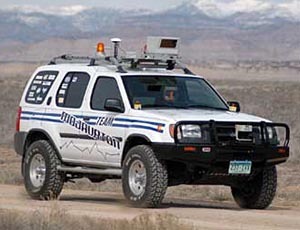DARPA Grand Challenge update #2: A chat with Team Mojavaton
Fontana (CA) - Not only is Team Mojavaton officially designated team #1 out of the 43 that made it to the qualification round, but they were also first to successfully complete the 2.2 mile route in the qualification round at the DARPA Grand Challenge. The team's 2001 Nissan Xterra, dubbed the "Xboxx," clipped just one obstacle in its run and team members believe it will do even better in the desert race. Tom's Hardware Guide chatted with Alan Peck, technical supervisor for the team about vehicle design and development.
Peck said that the Nissan Xterra was selected because it is "already off-road ready." Team Mojavaton did not want to spend much time customizing the car and intended to immediately control the vehicle and establish drive by wire quickly. In contrast, many of the other teams have burned quite some time trying to desert-proof their cars and the rushed the software development. While Peck realizes that the software is the "most difficult" part, he said, "You need to start with good hardware to make the software work."
The vehicle is powered by dual Xeon processors, which are placed in a rack in the trunk area. The code is written in C++ and runs on Windows XP. A surprising choice, as most of the other teams are using Linux/Unix variants, but Peck says, "we've had very few problems with that." But obtaining and coding the APIs for all the sensors was not easy: "We had help from our sponsors, but it was difficult and there were some long days spent on it."
Peck believes the vehicle will do well in the desert and was relaxing in a lawn chair when we walked up to the team's garage. Xboxx had just successfully finished the qualification course, which means the team does not have to worry for the rest of the week and can focus on the desert course instead. While the obstacle course at the Fontana Speedway is tough, the desert is a different environment. There is often low contrast between terrain and vegetation and there is a big problem with shadows and sunlight that can confuse vision sensors. "We've tailored our car to the desert course and not for the qualifying event. We just want to finish in the top 20 here," said Peck.
The obstacle avoidance code has been tailored to not make dramatic course changes. According to Peck, this is why the vehicle clipped a car during the qualification race and there is a paint mark on the bumper to prove it. In addition, Xboxx should not become confused and stop when sensors notice a puddle or a bush. According to Peck, water puddles tend to look like a cliff to the robots, with the LIDAR (Laser Radar) beams either bouncing off or being absorbed by the liquid. Since there is no return signal, the computers detect the upcoming puddle as infinite distance. That's where the bumblebee stereo cameras and DVT cameras mounted just behind the front windshield come into play. The cameras along with mission control software will override the erroneous signals coming from LIDAR and steer the vehicle through the puddle.
Get Tom's Hardware's best news and in-depth reviews, straight to your inbox.
Humphrey Cheung was a senior editor at Tom's Hardware, covering a range of topics on computing and consumer electronics. You can find more of his work in many major publications, including CNN and FOX, to name a few.
